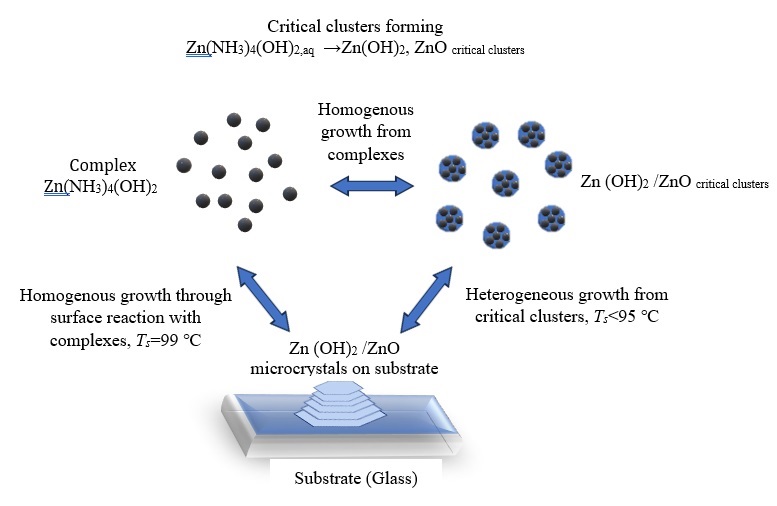Nanosystems: Phys. Chem. Math., 2024, 15 (4), 498–509
Kinetic of colloidal-chemical transformations during the decomposition of ammonia complexes of Zn(II) in alkaline solutions
Maria A. Maksimova – ISSC UB RAS, Ekaterinburg, Russia; msalimova1993@gmail.com
Evgeny V. Polyakov – ISSC UB RAS, Ekaterinburg, Russia; polyakov@ihim.uran.ru
Ilya V. Volkov – ISSC UB RAS, Ekaterinburg, Russia
Aleksandr P. Tyutyunnik – ISSC UB RAS, Ekaterinburg, Russia
Alexey A. Ioshin – ISSC UB RAS, Ekaterinburg, Russia; aaioshin@yandex.ru
Corresponding author: Maria A. Maksimova, msalimova1993@gmail.com
PACS 81.15.-z
DOI 10.17586/2220-8054-2024-15-4-498-509
ABSTRACT For the closed system (Σ): Zn2+–NH3,aq–NH3,gas, H+–OH-–N2,gas, experimental data on the change in the concentration of in the composition of the ammonia complex Zn(NH3)2+4 in solution, colloidal particles Zn(OH)2/ZnO in solution and growing film on the reactor walls are presented depending on the synthesis time, zinc concentration and synthesis temperature Ts in the range of 50 –99 °C. It has been established that up to 95 °C the ion-molecular growth of Zn(OH)2/ZnO clusters in solution (Σ) proceeds in a diffusion-controlled mode of homogeneous growth until reaching of their critical size. Further growth of ther critical clusters is followed by aggregation and coalescence of critical sized clusters into microcrystals with the formation of a film on a glass substrate of various morphologies. The solubility of such a film is determined by the size of critical clusters, which preserves in the growing polycrystal in the form of coherent scattering region (CSR). With an increase in the synthesis temperature to 99 °C, the aggregation mechanism is replaced by a faster diffusion-controlled attachment of Zn (II) ammonia complex to the end surface of the growing microcrystals simultaneously in colloid solution and in the film.
KEYWORDS Zn(II), ammonia complex, Zn(OH)2/ZnO, colloid, film, growth, mechanism
ACKNOWLEDGEMENTS The work was carried out with the support of the State Program of Fundamental Scientific Research of the Russian Federation (project No. 124020600007-8).
FOR CITATION Maksimova M.A., Polyakov E.V., Volkov I.V., Tyutyunnik A.P., Ioshin A.A. Kinetic of colloidalchemical transformations during the decomposition of ammonia complexes of Zn(II) in alkaline solutions. Nanosystems: Phys. Chem. Math., 2024, 15 (4), 498–509.
[In Russian] Максимова М. А., Поляков Е. В., Волков И. В., Тютюнник А. П., Иошин А. А.
Кинетика коллоидно-химических превращений при разложении аммиачных комплексов Zn(II) в щелочных растворах
АННОТАЦИЯ Для замкнутой системы (Σ): Zn2+–NH3,aq–NH3,gas, H+–OH-–N2,gas представлены экспериментальные данные по изменению концентрации Zn(II) в составе аммиачного комплекса Zn(NH3)2+4 в растворе, коллоидных частиц Zn(OH)2/ZnO в растворе и растущей плёнки на стенках реактора в зависимости от времени синтеза, концентрации цинка и температуры синтеза Ts в диапазоне 50 – 99 °С. Установлено, что до 95 °С ионно-молекулярный рост кластеров Zn(OH)2/ZnO в растворе (Σ) протекает в диффузионно-контролируемом режиме гомогенного роста до достижения их критического размера. Дальнейший рост критических кластеров сопровождается агрегацией и слиянием кластеров критического размера в микрокристаллы с образованием на стеклянной подложке плёнки различной морфологии. Растворимость такой плёнки определяется размерами критических кластеров, которые сохраняются в растущем поликристалле в виде областей когерентного рассеяния (ОКР). При повышении температуры синтеза до 99°С механизм агрегации сменяется более быстрым диффузионно-контролируемым присоединением аммиачного комплекса Zn (II) к торцевой поверхности растущих микрокристаллов одновременно в коллоидном растворе и в плёнке.
КЛЮЧЕВЫЕ СЛОВА Zn(II), аммиачный комплекс, Zn(OH)2/ZnO, коллоид, плёнка, рост, механизм
